Why Do Remakes Have To Be "Darker" and "Grittier"?
On revivals, reboots, and courting your audience.
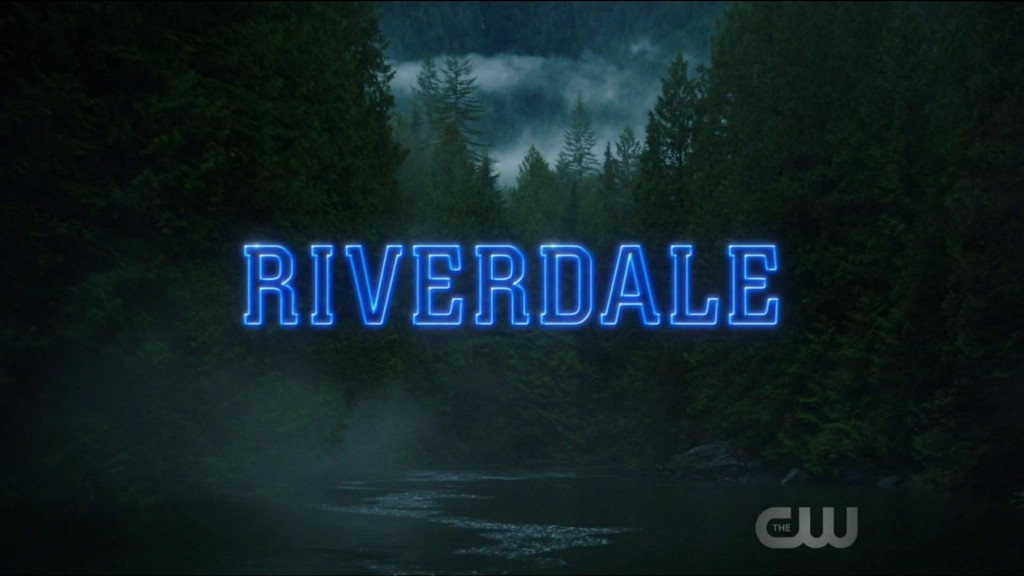
After going through our classic fairytales and the hale, hearty, wholesome world of Archie Andrews, Hollywood’s “darker and grittier” trend has finally come for Anne of Green Gables. The review headlines were all over my Twitter and Facebook feeds, decrying the “dark but predictable” and “bleak” “Anne With an E,” the Netflix reboot/revival/remake (who even knows, anymore?) of the classic series that dropped in March 2017. But why? Remakes are nothing new, but the type of remakes in development these days consistently emerge under a cloud of Dark and Edgy.
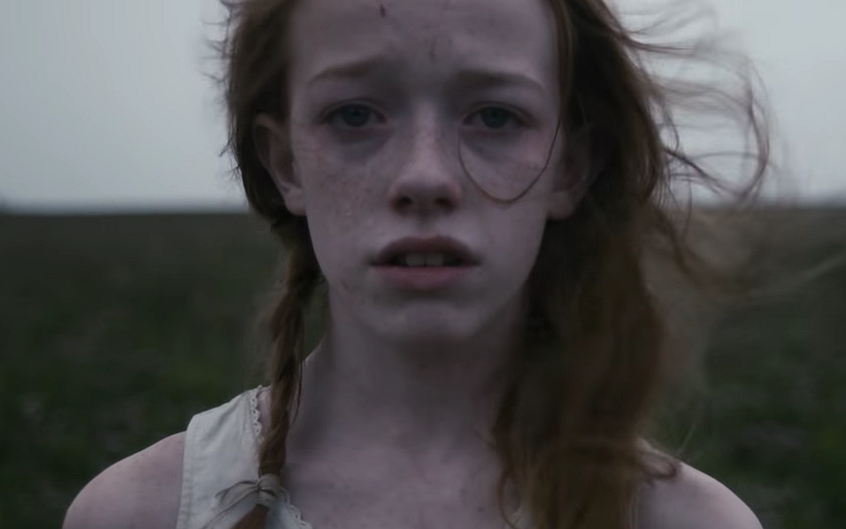
In the last few years alone, we’ve had a new-new Spider-Man, a new Batman, a new Power Rangers movie, a revival of “Full House,” “One Day at a Time,” “Arrested Development,” “Gilmore Girls,” “Samurai Jack,” and The Mummy, as well as variously faithful adaptations of Archie Comics, Anne of Green Gables, Snow White, Hansel and Gretel, Cinderella, and Beauty and the Beast.
Not all retreads of familiar media properties are created equal. Despite owing their existence to a pervasive sense of nostalgia, there are key differences between the revivals of “Gilmore Girls” and “Arrested Development” versus the adaptations and revivals of Archie Comics, Anne of Green Gables, and Power Rangers. The former capitalize on the nostalgia factor by recreating the original tone and style to a tee, while the latter, more controversially, have chosen to go “darker” and “grittier” — as in, “these aren’t the Power Rangers you remember from when you were five.” It’s a mix of desire and shame that older fans have to grapple with: if Power Rangers and superheroes are for kids, the way to make them seem appropriate is to remove the childish aspects and go the “darker-and-grittier” route, which results in popcorn movies attacking real-world issues with varying degrees of success.
One remaining question is, who are these reboots for? Are they doing so to attract that elusive, all-important Millennial viewer, capable of blowing up a show’s popularity with a single tweet? Or are they hoping to capitalize on the nostalgia of Generations X and Baby Boomer, in order to create a wider audience — and make these childhood properties seem more “adult” oriented? What underlying assumptions are the creators making about their intended audiences?

The urge to darker-and-grittier-ize is at least as old as the Brothers Grimm. We take it for granted that Disney sanitizes classic fairy tales, but don’t often consider that the violent “originals” by the Brothers Grimm are actually themselves adaptations of folktales from around the world — and the brothers took a fair few liberties with their own versions. Where an earlier written version of Cinderella by 17th-century author Charles Perrault ends with the stepsisters begging Cinderella for forgiveness, the Brothers Grimm amp it up for dramatic flair: not only do the stepsisters mangle their own feet to fit into the glass slipper, but pigeons also peck out their eyes as punishment for their wickedness.
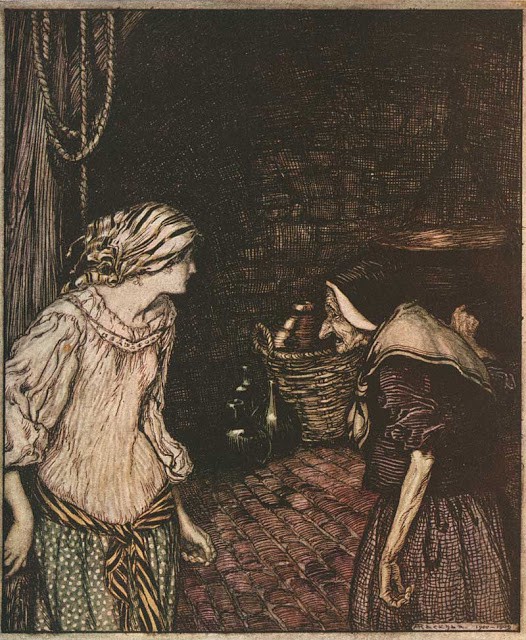
What was the purpose of changing these stories in this manner? Why take old folktales and dress them up in such disturbingly bloody ways? It turns out that the Brothers Grimm didn’t have children in mind when writing their own versions of these tales. According to the Christian Science Monitor, “[t]he brothers imagined their ‘Fairy Tails’ [sic] as an academic anthology. It was the work of scholars, compiled by and for serious adults. However, as the books became more popular, the Grimms faced harsh criticism. Parents found the stories far too dark […] So, the Brothers Grimm started editing.”
So the stories began one way, were turned dark and violent by the brothers Grimm, who gradually moderated them for child consumption, then made light and fluffy by Disney, only to be turned around and recast as sexy thrillers for the 21st century. If we take the example of the Brothers Grimm in reverse, if light and fluffy is designated for children, then the converse applies: adults (and, increasingly, millennials) apparently require more “serious” (and more violent or sexual) entertainment. (Although it is perhaps ironic to note that children’s movies have plenty of death and other depressing tropes, often more than movies geared towards adults.)
Thus, this darker and grittier approach is meant to attract both fans with memories of the original works — the older generation — while assuring them that, since the lighting has become moodier and people might be getting murdered, it’s now kosher to be a fan of Archie and Anne and the Rangers and still be an adult. There’s also likely the hope that parents will want to sit down with their kids and watch these movies/projects — to introduce them to this media that was so important to them in their youth. Gotta get those four quadrants!
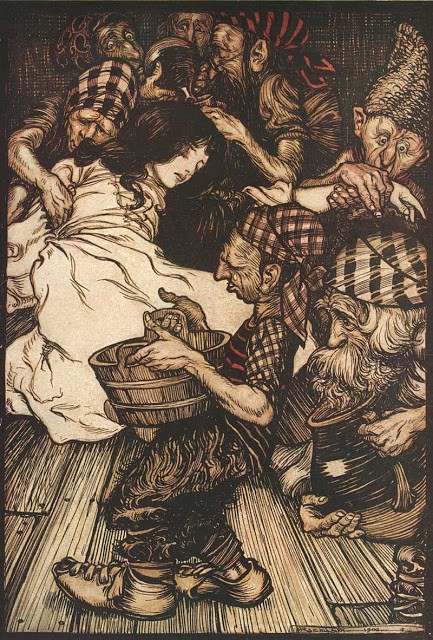
In contrast, the tone-matching approach of “Gilmore Girls” and “Arrested Development” has a much narrower, clearer function: these revivals are for the fans, so forget the rest of the world. It’s just not possible to jump into the new “Gilmore Girls” and “Arrested Development” without having watched them when they originally aired and still get what’s going on. “Riverdale,” Power Rangers, and “Anne with an E” serve no such function, and thus they have to court a wider potential audience — the people who know of the source material and/or previous adaptations who welcome a return of these characters (the people who are apparently longing for darker, grittier, and sexier and murder-ier fanfiction of their faves) as well as to the fresh eyes of discerning television viewers.
The present-day contexts in which “Riverdale,” Power Rangers, and “Anne with an E” are located also differ wildly from when they were originally introduced. When Archie, Anne, and the Power Rangers first showed up, their audience was largely children. But even though the CW is for teens, it’s still watched by plenty of adults, who recap its shows and write critical think pieces on them. Would a “Riverdale” that matched the precise tone of the comics — light, happy, slapstick, non-serialized — even be greenlighted, even if it was no longer a period piece? Would it have garnered such a strong following, and would it have become a guilty pleasure for probably a lot of adults in their thirties?

Archie Andrews first popped up in the 1940s and 1950s, and was supposed to be reminiscent of popular movie star Mickey Rooney. By the time he got his own series, he and his world were perfectly suited to the ideals of the era: a bright, clean town, everyone declaratively heterosexual (aside from Jughead, who was mostly more interested in food than in dating), front lawns, nuclear families, America as the greatest — a wholesome, idyllic vision of the United States. “Riverdale,” in contrast, responds to a very different world of 2016–2017, as well as to the recent television landscape, where the “whodunit” serialized murder mystery is present in popular shows like in “Big Little Lies,” “True Detective,” “Broadchurch,” and “The Killing,” to name but a few. If “Gossip Girl” were being made today, surely it too, would have a murder mystery thrown in as well.
“Mighty Morphin Power Rangers” — both the television show and the original movie — reached American audiences during the heyday of the booming 1990s, which was called “the best decade ever” by the New York Times in 2015. The economy was successful, the Cold War was over, and “a tide of progress and good sense seemed to be sweeping the whole world:”
By the end of the decade, in fact, there was so much good news — a federal budget surplus, dramatic reductions in violent crime (the murder rate in the United States declined by 41 percent) and in deaths from H.I.V./AIDS — that each astounding new achievement didn’t quite register as miraculous […] According to the annual count by Freedom House, the tally of the world’s free countries climbed from 65 at the beginning of the decade to 85 at the end. Since then, the total number of certified-free countries has increased by only four.
Opinion | The Best Decade Ever? The 1990s, Obviously
Much like “Friends,” “Mighty Morphin Power Rangers,” represented the cultural attitudes and optimism of the decade — it was brightly colored, hammy, didn’t take itself overly seriously, and was often more than a little funny. With “Friends,” however, the story being told the was the audience’s lives, albeit reflected back in a much more homogenized and idealized way, while “Mighty Morphin Power Rangers,” with its sci-fi and fantasy elements, was not exactly grounded in reality. Monica and Rachel’s impossibly large apartment was still a goal to which the viewer could aspire, unlike magical powers (although today both are arguably equally based in fantasy).
The question, then, becomes one of desire. What is it audiences are supposedly looking for? Is it truly nostalgia if the atmospheres of these reboots reflect our own times more than their original? Do we want Archie and Anne and the Rangers to take us back to their worlds, where everything is circumscribed by the lines of fiction and the promise of an eventual, often hard-earned happy ending, or do we want them to enter our own imperfect, confusing one? What is it about Stars Hollow that compels us still to return to its small-town charm, but requires that the superficially similar town of Riverdale become a veritable pit of snakes?
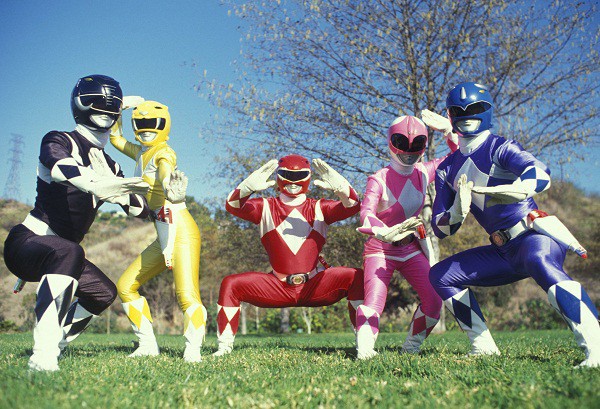
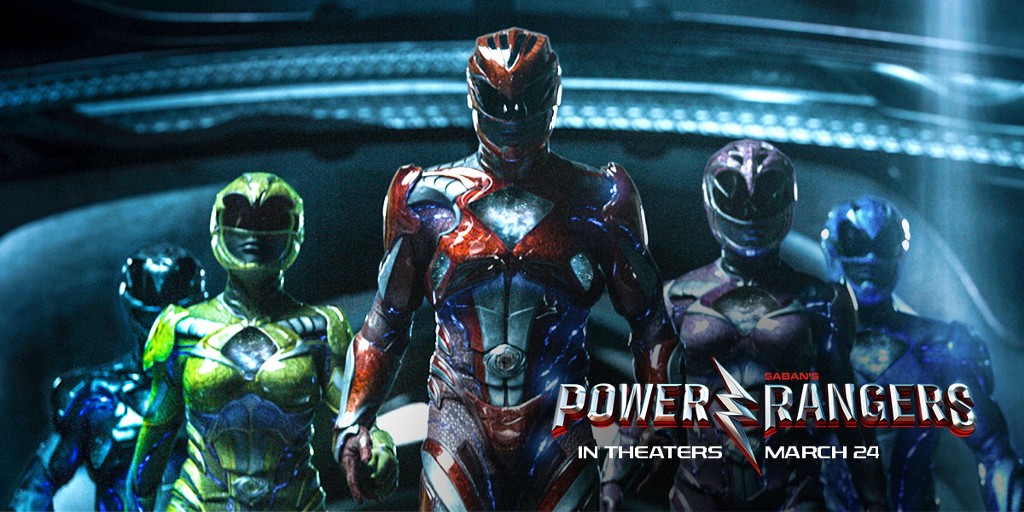
Perhaps Archie and Anne and the Rangers are so steeped in their historical lightness and earnestness that we have the urge to tear them down — to “modernize” them for today’s audience — while “Gilmore Girls” and “Arrested Development” feel recent enough. Today’s adult viewers, at least, still feel that twinge of shame and embarrassment when walking into the latest from Marvel Studios — that sense of “I can’t believe I’m a grown adult going to watch a man who becomes the size of an ant to fight crime.” The new look and feel of the town of Riverdale is well within the category of salacious, adult-friendly guilty pleasure, although the pleasure would be likely be even guiltier if the show were closer in tone to the source material. Essentially: we want to go back to the pristine, unchanged worlds of the Gilmores and the Bluths to comfort ourselves by remembering, perhaps, the happier times when we first met these characters; we want to “dark and gritty”-ify Archie, Anne, and the Rangers to justify returning to the texts of our own childhoods.
Ultimately, the “darker and grittier” approach doesn’t seem to be working on as large a scale as Hollywood might have hoped. While “Riverdale” is certainly talked-about in that breathless, I-can’t-believe-I’m-watching-a-show-about-sexy-Archie-Andrews way, it didn’t earn big viewing numbers. “Anne with an E,” despite an overall positive critical reaction, will hardly end up in the top half of popular or most-loved Netflix original series, and Power Rangers barely made back its budget, while earning mixed at-best reviews. Batman v. Superman: Dawn of Justice earned plenty of money but scathing reviews, while the more earnest Wonder Woman has succeeded both among critics and moviegoers. It’s not even clear whether the assumption that Millennials wanted “darker and grittier” was ever solid to begin with. Maybe we needed to grow up alongside Harry Potter, but we didn’t necessarily want to stay in that muddled, murky place where his story ended.
It seems, then, that we need to take a look at what we want from our media with regards to nostalgia, and what we hope to get out of that nostalgia in the first place. Perhaps, after a decade or so of insisting that “darker and grittier” is somehow more true to life or realistic (and therefore more worthy of our consideration), we’re looking for something more like pure escapism once more.
Deborah Krieger is a freelance writer and curatorial assistant. She has written for BUST, PopMatters, Paste, the Mary Sue, Whitehot Magazine, Bitch Flicks, and blogs at www.i-on-the-arts.com.
You Can Open Up a Relationship, But You Should Probably Just Break Up
And other unsolicited advice

“We are a couple thinking of having an open relationship. What do you think?” — Young & Restless
I was in love once. It wasn’t for me. But I applaud couples who are trying to shake things up, no matter what route they take. After a while in relationships sex becomes less erotic and more predictable. So, you know, become a furry or build a large lego sex dungeon. Whatever it takes. As far as I can tell, you only live once. Unless you’re a fan of the Buffalo Bills. Then you never had a chance to live at all.
Relationships are hard. How is it that the person you’re attracted to across some bar is also the person you’ll continue to want to fuck, have kids with and want to wake up next to for the rest of your life? Ignoring all other people you are attracted to across bars from? Monogamy may be great for the spread of Western hegemony, but it may not be great for your marriage after a while. Unless hegemony really lights your fire.
What do people want from each other in relationships? A few laughs, some sexy stuff. Maybe kids and a house. But mostly, just someone to be on your side. To be part of a team that’s cheering for you, that wants you to be happy. In the case of the open relationship, it’s a team that’s dedicated to getting you laid, too. But you have to let them get laid, too.
I’ve never been the jealous type in relationships. I’ve always just figured if someone else wanted to cheat, I could probably cheat, too. That’s what you’re supposed to do. Just cheat. People get off on the drama of the thing. The constant lying, betrayal, make-up sex, throwing stuff at each other. That’s part of the fun of even having someone on the side. So the people who open up their relationships are totally missing out on all the fun. Sneaking around. Writing poems. Doing something naughty. What’s the point if you have permission? Permission can sometimes be fun. But danger is funner.
Whatever deals you think you can make in relationships, whatever rules you think you can create, they will be broken, they will go south. It’s just impossible. I have no idea if open relationships can work long term. But if they could, why isn’t everyone in an open relationship? Fuck each other, both make out with the nanny: whatever. Because people get mad and jealous, and then they break up eventually. Nothing that good can last! I see these couples all the time on OkCupid looking for people to have sexytimes with together. I’ve had a few threesomes. They are a little weird and a little sad. I’m not saying you should avoid them. Just from a life experience kind of thing, they’re interesting. But it wouldn’t be the #1 thing on my list to be looking for. That right now would be someone to watch “Twin Peaks” naked with to explain to me what the hell is going on. And not naked David Lynch. I think he would just confuse me more.
Humans aren’t built for happiness, but it’s good to have unattainable goals in life. I do believe that there are some couples who can be happy together for a really long time. But they are as frequent as the ones who can pull of the whole open relationship thing and not get weird, not get jealous and not get resentful. There’s a difference between true happiness and settled-for happiness. And you’ll never be able to fool yourself for very long.
Sometimes the nicest thing you can ever do for someone is just break up with them. They will feel bad and then get over it and find someone else and then you’ll see them at the tea place on 7th Avenue and they will look good and you will say hi and flirt with them like you used to and they will smile and blush. And then you’ll go home and be like I can’t remember why I broke up with them! And it’s because there is no reason, we make up reasons. Everyone is weird and relationships are difficult and everyone’s timing is always bad. Do you think adding more people to a relationship will make things less complicated?
There are two kinds of open relationships. The ones where you tell each other all about the stuff you do, and the ones where you don’t. In general, try anything you can to be as close to happy as possible in this life that doesn’t purposefully and irrevocably hurt anyone else. If you think you’re capable of riding the wild pony, ride it until dawn. Or at least until it needs a rest and a little Gatorade. Every couple is different, and no one can truly know what a couple is like when no one else is around. It’s better to be upfront and honest, but everyone only hears what they want and ignores the rest. What’s the worst that could happen? You break up. Everybody breaks up now. It’s not the end of the world. If it was the end of the world, that would be kind of sexy.
Jim Behrle lives in Jersey City, NJ and works at a bookstore.
OXIA, "Less Time"
What if we don’t, week?

Weren’t we just here? Wasn’t it moments ago that we were waking up to a new week, full of dread and barely able to drag ourselves to the starting line? Didn’t we just complain about how exhausted we were and wonder how much more we could take? I guess the good news is I can copy and paste this exact block of text over and over again until it finally all comes down, because we live in a world where it’s always like this now. Here’s some music. Enjoy.
Bethany Beach, Delaware, July 20, 2017

★★★ The early light through the window raised brilliant cobalt-blue highlights on the bathroom faucet. Surf boomed; gulls left footprints on the new-raked sand. A thin crescent moon bowed toward a patch of gleaming pink where the sun was scheduled to be arriving. The horizon was a bright silver line. The appointed moment came with no visible change in the distant haze, but the mother-of-pearl shine on the water grew more and more lurid. Finally a little irregular fleck of bright red appeared and swiftly grew into a rising red circle, schematic as a tamari label. The gulls paid it no attention, while the lone body-boarder out in the water paused to watch it. The red went over to metallic orange, the color of something not quite remembered from childhood. The line of it undulated side to side across the water and now up onto the wetted sand. Orange fingers of foam reached once or twice all the way to the top of the steepest slope. Tiny figures of paddleboarders moved out to sea in sudden multiplicity, standing upright, like a line of pilgrims in a vast wilderness. A man swept a metal detector back and forth on the line leading out from the umbrella-rental stand. By the time the beach was full and lifeguarded, the regular day was savagely hot. If the trek to the water could be borne, the waves themselves were cool, and after a while a breeze came up to spread the chill from their breaking. It was enough to raise goosebumps. Four pelicans flew by in formation. The afternoon was full of glare, and the late air coming through the trolley was neither uncomfortable nor refreshing.
Stop Cashing In On Turning 30
You had your chance five years ago, where were you then?
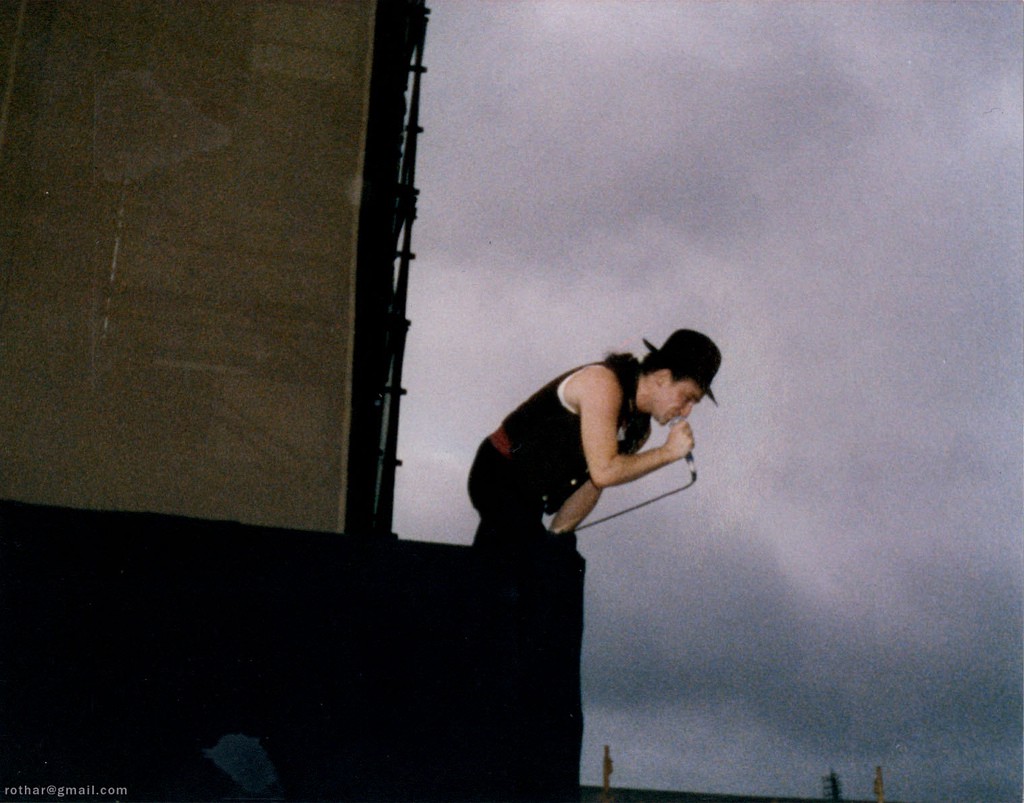
Listen up, culture-industrial complex, 30th anniversaries ARE NOT A THING. You can do 10, 20 and 25, but if for whatever reason you miss all those you just have to sit on your hands until 50 rolls around. This is some bullshit.
A Selection Of Heat Noises, In No Particular Order
Some suggestions for the obverse of ‘brr’
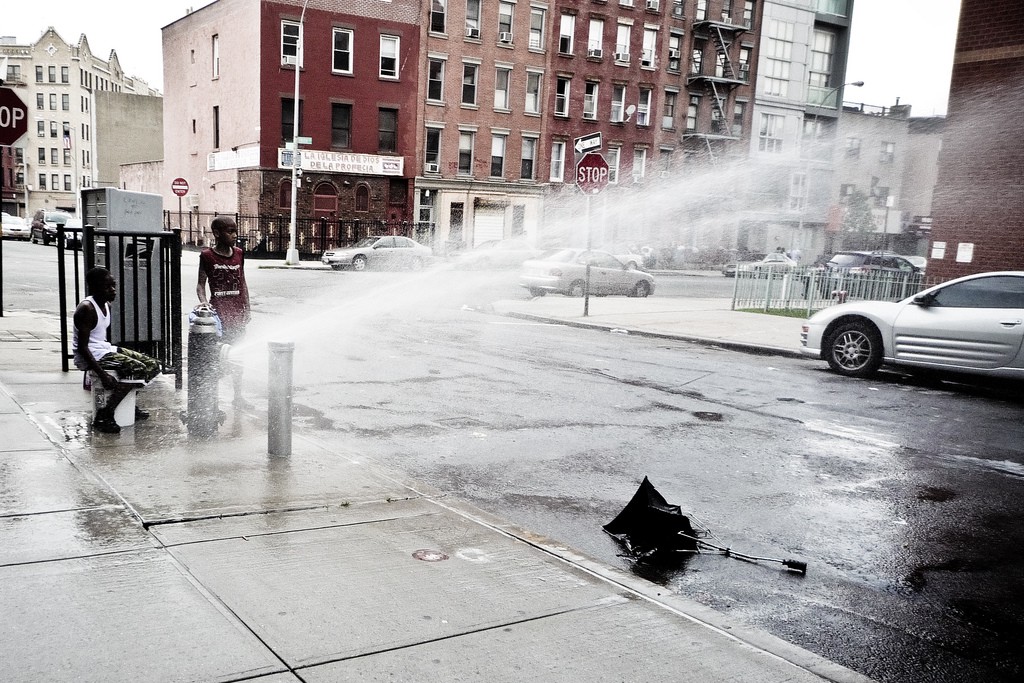
- Woof
- melting
- FML
- hot af
- Man it’s a hot one
- Yow
- arr
- “ssss” to indicate sizzling.
- buhh
- it would have to be like an “aahhh” that when you say it out loud sounds like an uncomfortable exhale
- “guhhhhhhhhhh”
- “How does one onomatopoeticize mouth-breathing?”
- Oy
- “whew!” while fanning one’s face…
- “hot enough for ya?”
- *whistle noise*
- Whew
- “Hoo.” Alternatively “Hooboy.”
- UFF-DA
- Fuuuggggghhhhhhhh
- “at least it’s not fucking windy”
- Phew (BrE)
- “Pluhhh” — but you have to say it slow, with a lazy tongue. The “p” evokes the drip of an AC unit, or the peeling of one’s butt off a seat.
- sheesh
- driiiiiiiiiip (drip)
- “It’s not the heat, its the humidity.”
- It’s that unavoidable gasp when you step outside and feel the weight of the heat bearing down on you.
- rrb
- “fwoof” like the sound you make when the weather is so hot it forces the air from your lungs
- [a word for when you pull your top away from your sweaty chest and fluff it to make a little breeze]
- *pants heavily*
Jared Kushner Hits the Campaign Trail

The KUSHNER FAMILY is taking an Uber to buy water and other supplies at a big box retailer. They’ve accompanied TRUMP to Michigan, where he is holding a campaign style rally after a disaster week where he admitted to reporters he would’ve never hired JEFF SESSIONS if he knew he’d recuse himself from the Russia investigation. Some other reporters made it worse when they revealed he had been asking around about how to pardon people, including the KUSHNER FAMILY. And then SEAN SPICER resigned. JARED is listening to music (Mike & the Mechanics’ “In the Living Years”), while IVANKA is holding up the palm of her hand and showing her children which part of Michigan they are in. There is much crosstalk but IVANKA has just called something “uncouth.”
UBER DRIVER [out of nowhere]: I’m kind of the goofy one in my family. [UBER DRIVER turns around in his seat and shows IVANKA a photo of him and his siblings, all making silly faces at a family gathering.] Which one of you would you say is the goofy one?
IVANKA [not engaging]: Here will be fine. Thank you.
UBER DRIVER [pulling into the fire lane]: My mom used to take country line dancing at this Meijer. [The UBER DRIVER gestures to the big box retailer, a beloved Michigan institution, to his left.] Well, before it was a Meijer it used to just be like a regular strip mall. There was an eye doctor and, like, a little convenience store, and then, I guess you would call it a dance studio. But she took line dancing there.
IVANKA [to her children]: He’ll leave the meter running and we will wait for daddy inside the car.
UBER DRIVER [sarcastically]: Madam President, it doesn’t work like that.
KUSHNER DAUGHTER [looking up from her book, Angela’s Ashes]: Mommy, you said automation was taking their job. That’s a person.
KUSHNER SON [anxiously]: Mr. Steve said war will come when all the truck drivers realize that robots—
KUSHNER DAUGHTER [interrupting her brother, as her mother taught her]: He showed us a map of the United States. The most common job in a critical mass of states is truck driver.
IVANKA [calmly]: When did Mr. Steve teach you all this?
KUSHNER DAUGHTER [taking a piece of gum from the UBER DRIVER’s array and using the wrapper as a book mark]: When daddy goes on break.
IVANKA [curtly, to JARED]: Go. You’re not going to see anyone you know at a store in the middle of Michigan.
JARED heeds IVANKA and enters the store. The rows and rows of aisles, full of non-perishable food, clothing, patio furniture, automotive parts and lawn mowers, remind him that he never liked summer camp. A pit manifests in his stomach as he worries about not being able to call his mother until, well, whenever the counselors let him use the phone in the nurse’s office. A STORE CLERK, retirement age and wearing a Meijer apron, approaches JARED, and brings him back to Earth.
STORE CLERK [lisping slightly]: You’re the boy married to the President’s daughter. It’s an honor to meet you. I’m Ann. Is there anything I can help you with?
JARED: We’re having — [JARED can’t remember why he is in Michigan.] I can’t remember. We need something to drink and something to eat. Not much though, and the campaign will pay for it.
STORE CLERK [imagining what a rich person would like to eat]: We have a nice olive selection in our condiment aisle. Do you see the hot dog and hamburger buns right there? It’s down there.
JARED: Do you have Wasabi peas?
The STORE CLERK scrunches her forehead. She removes the walkie-talkie from her belt and asks her manager where Wasabi peas would be located. She explains that the boy who works for the President is asking, so if she could find out quickly, that would be very much appreciated.
STORE CLERK [to JARED]: If we do, they’d be in our snack aisle. Or maybe by the checkout.
JARED ventures off, aimlessly because he has no idea where the snack aisle or the checkout is. Ann, the STORE CLERK, calls her husband and lets him know that she met IVANKA’s husband, and that he seems very stressed, lost even. Her husband is honestly not surprised, but he is still happy he voted the way he did. Thirty minutes later, JARED makes his way to a self-checkout line, where the credit card reader confuses him. Ann, the STORE CLERK, again intervenes on his behalf.
STORE CLERK [motioning to JARED’s credit card]: Does your card have a chip?
JARED: Can I just PayPal you?
STORE CLERK: I’d have to ask my manager. [She radios her manager, again, who is getting a little sick of all the questions today.]
JARED [to himself]: Do you know how sometimes, just as you’re falling asleep, it feels like you’re falling like down a hole?
The STORE CLERK smiles because she does know what that feels like. Meanwhile, outside, IVANKA is waiting impatiently with the KUSHNER CHILDREN. They’re climbing up the ladder attached to an RV parked across four handicapped spaces. A Blue Lives Matter decal glistens in the summer sun. The RV starts itself and the KUSHNER CHILDREN, frightened, run to their mother. There’s uproarious laughter and then the fart noises a pair of flip flops makes when you first start wearing them. It’s STEVE BANNON.
STEVE BANNON [just kidding]: Get the fuck off Clarence Thomas’s RV!
IVANKA [curious, for once]: You got to Michigan the same time we did. When did you leave D.C.?
STEVE BANNON [unshowered]: As soon as I okayed the New York Times interview.
KUSHNER SON [pulling at IVANKA’s shirt]: Mr. Steve smells like morning.
IVANKA [beseechingly]: Steve, go take a shower or whatever you do to clean yourself.
Not about to start listening to what a Trump says, STEVE BANNON peels the lid off of a small can of food. He takes a deep whiff, pulls a plastic knife from his cargo shorts pocket, and digs out the meat.
STEVE BANNON [lying]: It’s paté. Try some.
KUSHNER SON [afraid]: Mommy, Mr. Steve is eating cat food.
IVANKA [gagging]: It is cat food.
STEVE BANNON [literally consuming cat food]: Paté arbitrage. It’s the only useful thing I learned at Goldman Sachs.
KUSHNER DAUGHTER [wisely]: You didn’t learn to eat cat food at Goldman.
STEVE BANNON: I learned how to arbitrage. [STEVE BANNON shows the label of the can. It reads Friskies Chicken Livers.] Much cheaper. And not subject to the same regulations as people food.
JARED emerges from the Meijer with a full shopping cart. He feels safe, especially after the STORE CLERK coached him through his first self-checkout.
JARED [proudly]: I also got us a pizza. [JARED tilts the Little Caesar’s box towards his family.] Ann said we could fry an egg and make some garlic spinach if we wanted to be a little gourmet about it. Here is a wok for the spinach. [JARED holds up a wok he bought with campaign funds.]
IVANKA [powerfully]: But did you get full-calorie beverages and party mix for the crowds at the rally?
[JARED points to a twelve pack of LaCroix sparkling water and a re-sealable bag of Wasabi peas.]
KUSHNER SON [standing on the end of the shopping cart]: Mommy, what’s “pamplemousse”?
IVANKA [consolidating power]: Steve, our Uber driver told us that he heard the Democrats’ new slogan is “Better skills, better jobs, better wages” and now he is voting for them in 2018.
STEVE BANNON [still eating cat food]: Bullshit.
[IVANKA and STEVE BANNON snicker evilly as JARED demonstrates to his children how he plans to stir fry the spinach in CLARENCE THOMAS’s RV. Then he’ll plop some on a slice and top with a fried egg. He makes a kiss with his hand like he is a chef. His children’s amusement validates him.]
We Have Nothing Worse Than Death To Fear
What the Finnish word ‘sisu’ has meant, and what it means to me.
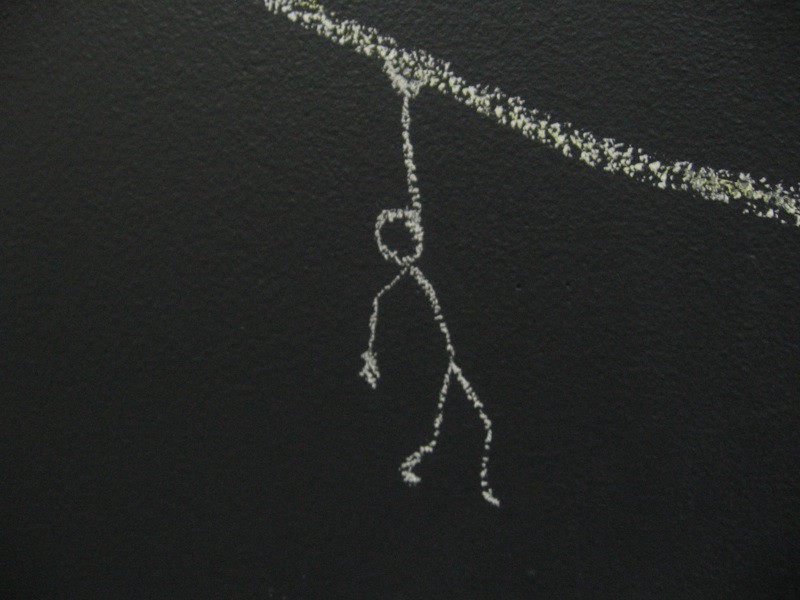
In March of 2016, a cartoon by New Yorker cartoonist David Sipress began appearing on my social media feed with increasing frequency. It was a black-and-white sketch of a man and a woman walking down a city street with the caption, “My desire to stay informed is currently at odds with my desire to stay sane.” Essayist Janna Malamud Smith once wrote that a work becomes a classic in proportion to how many people find within it something intimately necessary. The same can be said for viral Internet sensations. After November 8th, the cartoon experienced an unsurprising renaissance. When I heard Donald Trump withdrew the United States from the Paris Climate Agreement, I awaited its third resurgence. Staying simultaneously informed and operative will be, for the foreseeable future, a precarious balancing act. I hereby present the antidote to this dilemma. It is called sisu.
Sisu is a Finnish word that carries an almost mystical ethos in my hometown, Houghton, Michigan. Finnish-American families, whose ancestors migrated to the region for work during the 1800s copper boom, dominate the area. Sisu is an un-translatable tenacity believed to be implanted in our genetic code. There is a stark distinction, of course, between being Finnish-American and being Finnish. My great-grandparents were first-generation immigrants and my grandmother’s DNA can be traced back to Finland’s indigenous Sami population, but at eighty-five she only made it to the motherland last year. I identify strongly with my heritage, but I am Finnish-American. Not Finnish. My definition of sisu is colored with an expected level of Americanization.
I lean on Woolf’s Mrs. Dalloway to define sisu. I think of Peter Walsh reflecting on how Clarissa lives with an unshakable awareness that we are a doomed race, chained to a sinking ship, and that the whole thing is a bad joke, but still feels obligated to mitigate the suffering of her fellow prisoners. Sisu means that, even in the face of probable Armageddon, you get out of bed and buy the fucking flowers yourself if that’s what needs doing. It’s a no-frills tenacity, resolve without any expectation of triumph.
In Finland, however, sisu is more complicated. Sisu is stained with historical context it lacks in the United States. I talked to Jari Katajamäki, a digital marketing specialist living in the Finnish city of Tampere, about his sentiments on the word as a modern Finnish citizen.
“Sisu is not in every day language anymore,” he said, “So when someone talks about sisu nowadays, we Finns immediately think about the Winter War. And, in that sense, I see sisu as a means of propaganda.”
In upper Michigan, the Winter War, fought from 1939 to 1940, feels unreal. It’s viewed as an almost mythical battle, Finland the slingshot-wielding peasant facing off against the insurmountable giant of the Soviet Union. But it was morally complicated and only partially victorious. When Finland refused to cede land to the U.S.S.R, the Soviet Union withdrew from a non-aggression pact and retaliated. Finland won, but the victory was short lived — the U.S.S.R continued military aggression in what is now known as the Continuation War. Here, things get ethically questionable — Finland welcomed assistance from Nazi Germany in the fight to preserve their homeland.
Sisu was used as propaganda. Some soldiers wore patches on their shoulders reading “sisu” and its resurgence in usage popularized the word in English for the first time. Sisu came to signify overwrought Finnish pride more so than serene resolution. Personally, I do not have a problem with sisu having been used in this fashion, given the circumstances. We are obligated to fight against the Joseph Stalins of the world and propaganda — however much it waters down intricacies — can breed vital enthusiasm. When a world power roughly 66 times your size threatens your autonomy, extreme patriotism becomes an asset. But propaganda never comes without consequence. Fervor spurred by the unexamined consumption of language can just as easily be steered in a regressive direction as a progressive one. In modern Finland, sisu is now associated with unsavory knee-jerk nationalism.
“Today,” Katajamäki told me, “Sisu is a word that seems to be used only by racists . . . . trying to convince us to close our borders and send all the immigrants back home.”
He then e-mailed me a link to Soumen Sisu, a Finnish political organization that opposes immigration and multi-nationalism and is infamous for publishing cartoons featuring images of the prophet Muhammad.
It pained me to see sisu used in this fashion, but Katajamäki, assured me many Finns still have a personal, largely apolitical, connection to the term. While the word is not widely used in modern Finland, it remains widely felt.
“[Finns] have always been close with nature and lived in an environment that hasn’t been the easiest to survive in,” he said, “And here lies the essence of sisu: the surrounding nature lives in our inner nature. It lives in what every Finn gets from his/her mother’s milk. Sisu gives us the strength and willpower to tame the nature — both the surrounding and inner nature.”
This is far more akin to my definition of the term, lacking patriotism’s self-congratulatory smugness. When used as propaganda, sisu was seen as a means to overcome difficulty. Overcoming, however, was never so much the point. It is the endurance that matters — the gall to survive the inhospitable.
This subdued brand of sisu became important for Finns in the aftermath of the Winter War. In an attempt to avoid further aggression, Finland adopted a stance of neutrality toward the Soviet Union. It was a tense time as Finland navigated sharing a heavily disputed border with the nation widely considered the greatest threat to world stability. In 1952, a Finnish newspaper reporter described the new Finnish currency as “dollar type,” referring purely to the bill’s cosmetic appearance. An editor vetoed the phrase on the grounds such diction was antagonistic to the U.S.S.R. In America, sentiments towards Finland soured. The term “Finlandizaton” was coined, referring to the process of passively adhering to Soviet interests. Finland was now synonymous with kowtowing to the U.S.S.R rather than resisting it.
During the Winter War, Time magazine helped popularize the term sisu in the United States. In a 1943 article, they defined sisu in a fashion that would become more apt in the ’50s, given widespread Cold War-inspired fear. The article defined sisu as a stoic courage, the ability to march forward without any illusions about the potential of imminent disaster. The writer notes, “The Finns are not happy. But sisu enables them to say, ‘We have nothing worse than death to fear.’”
In Alice Munro’s “The Love of a Good Woman,” the protagonist recalls a dream she had as a young girl in which she walked in on her father suckling the breast of an oddly dressed woman in his office. When she tries to tell her mother about the incident, she does not know the word for breast. She describes it as an ice cream cone, morphing the unknown flesh into something familiar. “A biscuit-colored cone,” she recalls, “with its mound of vanilla ice cream squashed against the woman’s chest.” To me, an atheist, this is how we think of God. In comparison to the cosmos, we are very young; we do not yet understand reality. To call what drives creation God is to call a tit an ice cream cone — a child’s vision, grappling with mystery through palatable terms.
This brand of uncertainty provides me with inordinate comfort. It does not make me fear death more, but less. This mentality stems from my Finnish-American upbringing. My grandmother, who remains very much alive, had her own tombstone erected about ten years ago. Now well into her eighties, she has never expressed any particular fear of mortality. We have nothing worse than death to fear, I imagine her thinking, and for all we know it won’t be that bad.
To tame nature is to live despite nature. This ability to stare down mortality is sisu. It’s knowing, as Clarissa knew, that death ends completely, but not giving a shit, because buying the flowers remains your priority.
After hearing the news about the Paris Agreement, I went to the gym. I watched the ensuing press conference on the screen of the elliptical machine, cringing as Sean Spicer dodged question after question regarding whether the president believes in climate change. I was born in the eighties, so global warming has always been part of my reality. I have never known an earth that was not dying. My lifelong fear of Armageddon is mounting.
I lean on sisu to endure. I am not happy, but I have nothing worse than death to fear.
Erin Wisti is a freelance writer and editor living Los Angeles. Her essays have previously appeared in NPR’s The Salt, Ravishly, The Toast, Ampersand Review, and other places.
The Revolutionary Hope of George Romero's 'Land of the Dead'
It’s less celebrated, but worth revisiting
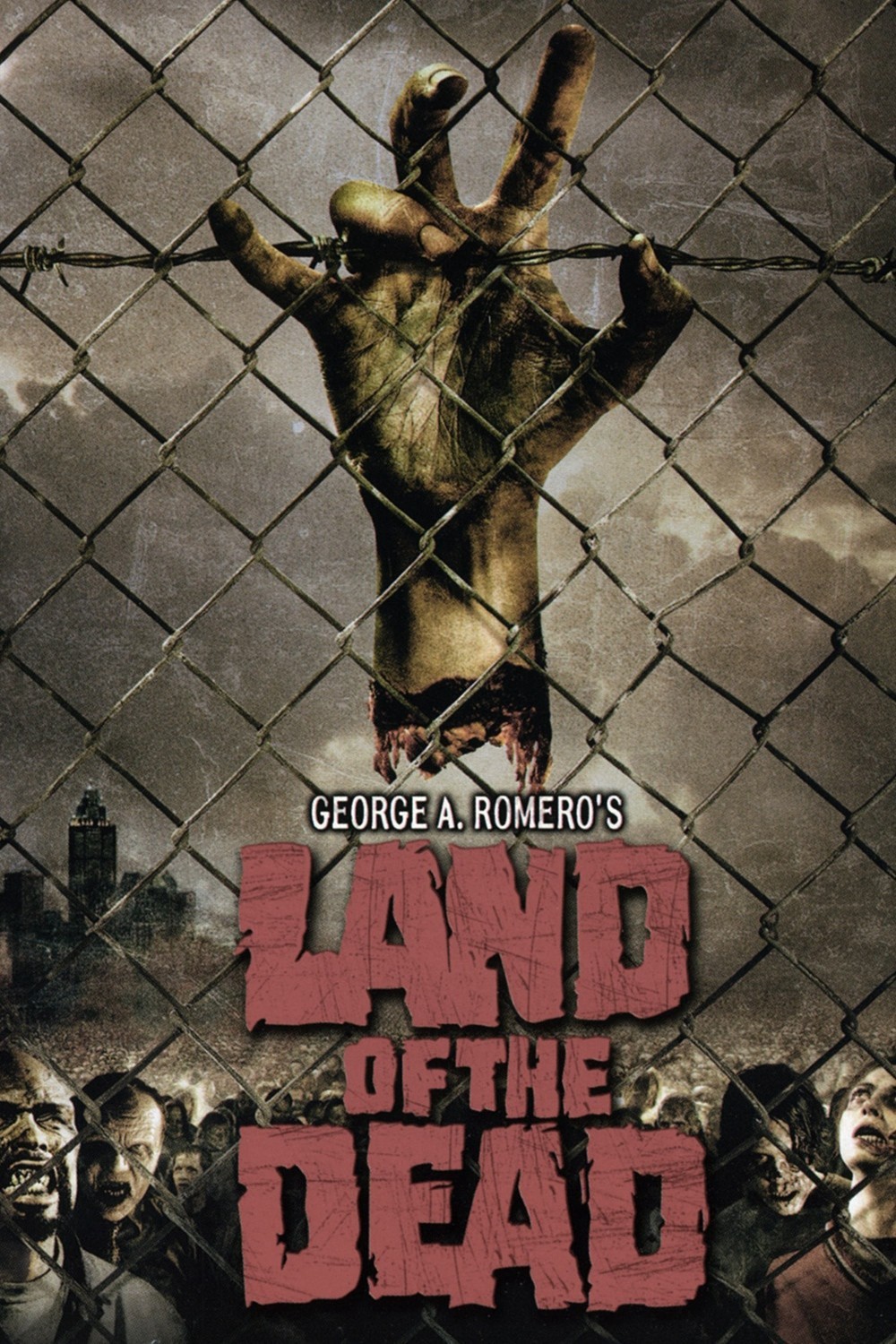
When the obituaries for director George A. Romero — who died on Sunday, at age 77 — came out, the credits mentioned were rightfully obvious. Here lies the renegade director who invented the zombie genre with Night of the Living Dead, then Dawn and Day of the Dead. But what’s missing in the obits is praise for the most underrated entry in his zombie oeuvre: 2005’s Land of the Dead.
It’s his only zombie movie with any “star power,” (including Simon Baker, Asia Argento, John Leguizamo, and Dennis Hopper), but it’s also his only zombie movie — and one of the few in the whole genre — that take place in the world after the outbreak. Humanity has regrouped from the shock; they’ve gotten used to it. They know how to kill them, they’ve fortified safe areas, even captured a few for entertainment, like target practice or, “take your photo with a zombie” shlock. Also returning into our pieced-together world? Our good old friend, class dynamics.
Most of the film takes place in downtown Pittsburgh’s Golden Triangle, a zone made zombie-free by protection from two rivers and one heavily barricaded front. The city is an extended shanty-town — complete with end-of-the-world preachers, campfires, even a minimal puppet theater. The one notable exception: Fiddler’s Green, the lush high-rise presided over by Paul Kaufman (Dennis Hopper) in a quasi-feudal king role. While outside there is hunger and disease, behind the complex’s hired security force, the ruling elite live in luxury. Soft music plays, fountains drone their contemplative patter, “Greenies” window-shop at the season’s latest fashions. It’s an elite circle everyone wants to get into, but space is very limited.
But the city has basic survival needs — they’ve already raided the downtown grocery stores, and there’s no room to grow crops. Enter the “raiding parties,” city-sanctioned teams allowed outside the city gates to retrieve needed items.
Viewed through the lens of Marxism (because why not), those in the Green are the bourgeoisie, while those in the shantytowns are the proletariat. There’s a small group of revolutionaries living in the shantytown, whispering about overthrowing Kaufman’s reign (“he kept the best for himself and left a slum for us,” says a rabble-rouser with an Irish accent, “if all of you would join up, we can make this a fit place to live in!”). What’s kept them in place? Guns and money, sure. But more than that, it’s the dual lures of safety (“we will protect your innards from becoming zombie meal”) and upward mobility (ads for Fiddler’s Green play for the populace, despite vacancies being nonexistent). By using these to splinter the lower-class, the ruling class is allowed to reign unquestioned.
When we get our first glimpse of zombies, they’re introduced as former humans going through the motions of a quaint small-town American existence. There’s the cheerleader, her jock boyfriend, even a three-piece brass ensemble in a bandshell awkwardly fumbling with their instruments. The film’s “hero” zombie (known as “Big Daddy” in the credits) works as a gas attendant, coming out to pump for a car that isn’t there. But when the tranquility of their wholesome “1950s” existence is ruptured by a raiding party, they start to change in ways that are very un-zombie-like. Under the guidance of Big Daddy — the first “woke” zombie — they begin to communicate with one another, use weapons, even show emotion when other zombies are slaughtered. (This emotional progression was hinted at with the character of Bub in Day of the Dead.)
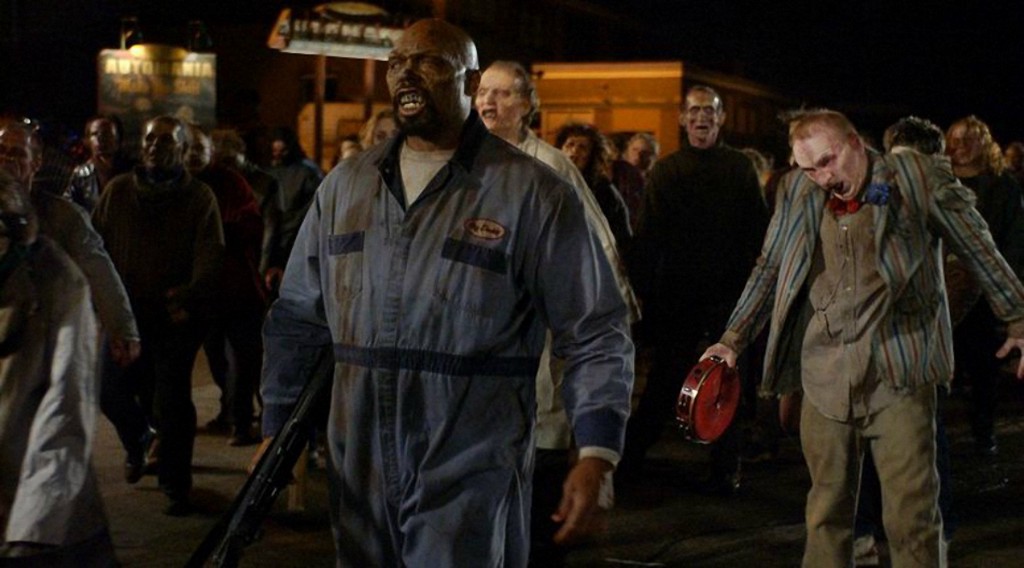
Romero’s use of zombies as stand-ins to criticize American culture was always blunt, whether it’s Night unveiling the accepted racism of Jim Crow-era America, or the ’80s consumerism predicted by Dawn. So, what the hell are we to make of the nearly functional zombies in Land? Are they the lower-class, the “waste humans” that have been around since America’s founding, exploited by the upper- and middle-class? Are they (we?) the Americans that are still too distracted by shiny things — one way raiding parties get past the hordes is by capturing their attention with fireworks — to notice the growing inequality? Are we one vocal and inspirational leader away from collectively seizing power for ourselves?
The collective action is, of course, what makes the slow-moving zombies of Romero more terrifying than the virally spread “runner” cousins in the post-28 Days Later era. The latter can be combatted with a scientific “cure,” the former are a movement that’s only getting bigger. One slow-mover isn’t scary, neither are two or three; it’s only bad when they mass enough to cut off escape routes, when however many bullets you have aren’t enough. And the end of Land is the same as all Romero zombie movies, that is, the zombies win and the humans (the “real” monsters, after all) are back on the run.
But this time, it ends with a team-up (of sorts) between the newly woke zombies and the shantytown outsiders. After Fiddler’s Green is destroyed, after the intestines of the elite are devoured, Big Daddy and Riley see each other in the distance, each leading their pack of survivors in different directions. One of Riley’s team members prepares to mow them down, but then Riley stops her. “They’re just looking for a place to go,” he says. In oura landscape of skyrocketing rents, migrant workers ducking past increasingly fortified man-made borders, and desperate refugees on the run from political wars, aren’t we all.

